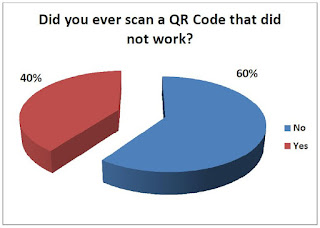Welcome to my blog about QR Codes in Ireland where i will be detailing everything you need to know about QR Codes. Feel free to ask me anything and i hope i can provide you with the information you require. .. afterall I've completed a 20,000 word thesis on them : )
Thursday, 22 November 2012
Some reasons why people don't scan!
Do not have QR Code App on Phone:
One third of people do not scan a QR Code because they do not possess a QR Code Application (App) on their phone. Responses from another question in my survey suggests that a QR Code Reader has only been installed on 13% of respondents phones. (This means that when a person buys a new phone the QR Code Reader application is already pre-installed on their phone). Therefore, 87% of respondents had to go and download this application. There are many applications pre-installed on smartphones in Ireland though the QR Code Reader is not among these high rankings.
It doesn’t interest me:
28% of respondents have confessed that it does not interest them. Lack of creative scanning results or outcomes could be the reason for this. On many occasions a QR Code will translate to boring content or useless information for the user. QR Codes can appear novel for the marketing manager and they may be excited to use them on marketing material. However, not making the outcome creative, unique and interesting may infer respondent’s negativity towards them. A study by Onmobile demonstrated that out of the 1,200 consumers surveyed, over half were not as impressed with the information they got from scanning a code, with only 41% reporting the information they got to be useful.
I don’t know how to scan it:
Almost one quarter of respondents said they did not know how to scan a QR Code. Whose fault is this? It could be argued that it is up to oneself to learn how to scan a QR Code. However, there is evidence that in fact this is the role of the QR Code developer (marketing).
Education by companies displaying their QR Codes needs to be implemented. Many QR Codes present themselves without any indication of what it actually is or/and what you can benefit from scanning it.
I did not know it could be scanned:
The final reason by 20% of respondents for not scanning a QR Code was that they did not know a QR Code could actually be scanned. Again, lack of information next to the QR Code could be a reason for this. Alternatively, the impact of other codes in the product packaging arena could offer further suggestions. It has been observed that Data Matrix Codes for logistical reasons are appearing on everyday goods which are not intended to be scanned by the consumer. They are smaller in appearance yet similar in design. People may feel that the QR Code belongs to this family and therefore are not intended to be scanned. One respondent in my survey replied
“Didn't find info from codes scanned of products in supermarkets useful at all. Often just a number comes up”. This is indicative of a Data Matrix Code scan result which is most cases leads to a product code number. Here, the user has confused the Data Matrix code as a QR Code.
Additionally, there is plenty of evidence of scan fails (A QR Code that does not have the intended outcome such as an out of date link) - A scan fail could be a lost customer. Imagine, this is the first a user has scanned a QR Code and the result was either a poor outcome of a total scan fail. This perturbs the user and may distract them from scanning ever again.
Below, results that show 40% of respondents scanned a QR Code that did not work!!!
Subscribe to:
Post Comments (Atom)


No comments:
Post a Comment